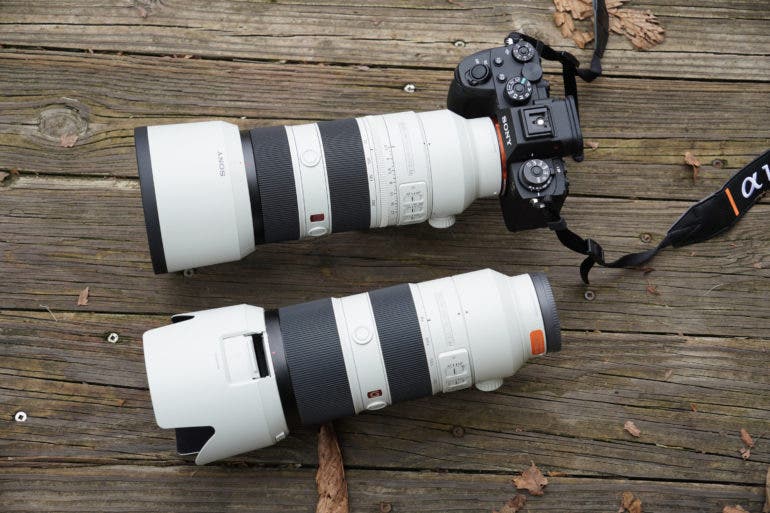Tested: Which Sony 70-200mm F2.8 GM OSS Is Better?
Sony’s well-loved 70-200mm f2.8 workhorse lens is getting a makeover. Announced on Oct. 13, the Sony 70-200mm f2.8 GM OSS II has a number of improvements, including upgraded autofocus, an aperture ring, and improved optics. But, Sony says that the original lens isn’t going anywhere, at least not yet. So what’s the difference between the two lenses? Is the Sony 70-200mm f2.8 GM OSS II worth the higher price point?
I spent a week with these two lenses on the Sony a1. The new optic is impressively fast and sharp. But, for the right price, the original Sony 70-200mm f2.8 GM OSS isn’t necessarily a bad buy.
Design: Sony 70-200mm f2.8 GM OSS II Vs. Sony 70-200mm f2.8 GM OSS

At first glance, the lenses both seem very similar until you pick them up. The new lens is almost 30 percent lighter and weighs about 36 ounces. While a few ounces is hard to tell, it’s a significant enough weight loss to notice while out shooting. Sony even says it’s the lightest full-frame f2.8 70-200mm. Of course, it’s still a workhorse zoom, so it’s not light, but it’s not quite the beast of the earlier version.

The other major design change is the addition of an aperture ring. The click to the ring can be turned on and off. There’s an Iris Lock switch that will prevent the lens from leaving the A or Auto position, while also preventing accidentally spinning the aperture to A as well.
The new lens also has a Full-Time DMF switch. This allows you to use the manual focus ring to adjust what the autofocus has selected. If the autofocus isn’t quite right, using DMF may be easier than using manual focus from scratch. The previous lens still has that capability, but there’s no on-off switch for it on the lens.
Autofocus: Sony 70-200mm f2.8 GM OSS II Vs. Sony 70-200mm f2.8 GM OSS

Mounted on the Sony a1, there’s a significant difference in the autofocus performance between the two lenses. The new version of the lens has four XD linear autofocus motors. The Sony 70-200mm f2.8 GM OSS II had just a five percent miss rate with a toddler running straight at the camera. The older version of the lens had a ten percent miss rate. It’s minor enough that the difference on Sony’s more basic model bodies won’t be as noticeable. But, the older lens still missed twice as much.
Another major change is that the lens can focus much closer. The new lens focuses on objects as close as about 1.4 feet away. The older version of the lens needs more than three feet. I noticed a significant difference in my ability to get in close to subjects with the new lens. And, getting in closer is also going to create smoother backgrounds than the 200mm and f2.8 alone.

The autofocus is also noticeably quieter on the new lens. There are sometimes a few clicks. But comparatively speaking, the older lens made a lot more grinding noises.
Image Quality: Sony 70-200mm f2.8 GM OSS II Vs. Sony 70-200mm f2.8 GM OSS


During my week with these two lenses, I didn’t notice major differences in color, flare, or aberrations. What I noticed was sharpness. The newer lens is sharper for more of the frame. The Mark II has some slight softness in the corners and around the edges — about 10 percent in. The softness on the original version of the lens was probably twice that. The softer edges started much sooner on the older lens. The standards for what sharp looks like have improved over the last five years, and the Sony 70-200mm f2.8 GM OSS II has sharper images.
That’s not to say that the original version is bad. But, you want to avoid putting details on the edges of the frame with the original more so than the Mark II.
Is the New Lens Actually Worth It?
If you shoot action and have a newer, faster Sony body, the 70-200mm f2.8 GM OSS II is going to deliver the best autofocus. But, besides speed, the newer lens focuses closer. It’s sharper for more of the image. And, of course, there’s that beautiful aperture ring and the lighter design. It’s also going to be more future-proof. If, say, a photographer opts for the old lens because they are just shooting with the a7 III, will they upgrade the body and down the road wish for the newer lens? It’s a great workhorse lens.
If you already have the original lens and are disappointed in the autofocus, corner sharpness, and size, the new glass is going to help those issues. But, if you’re happy with the old lens and don’t shoot fast subjects, the differences are probably too small to warrant dropping another $2k+.
For photographers who don’t yet have a 70-200mm, the choice is going to rely both on price, subject, and the camera body that it’s paired with. The new lens retails for $2,799; the original is about $200 less new, but it’s unclear if the price will drop even further. The old lens is expected to stay on the market, at least for now. Photographers with the a1 or a9 should opt for the faster lens. Photographers on the entry to mid-level bodies? It’s going to come down to price and how much that extra sharpness, closer focus, and aperture ring matter. If the price difference stays at $200 (less than 10 percent of the total cost) the added sharpness and enhanced design is worth it. But, if there’s a significant price difference and the choice is between the old lens and a narrower aperture lens, the old 70-200mm f2.8 can still capture good shots.
Interested in one or the other? Check them out on Amazon.